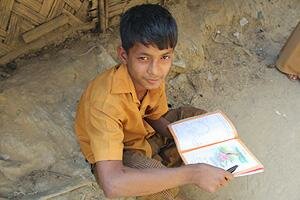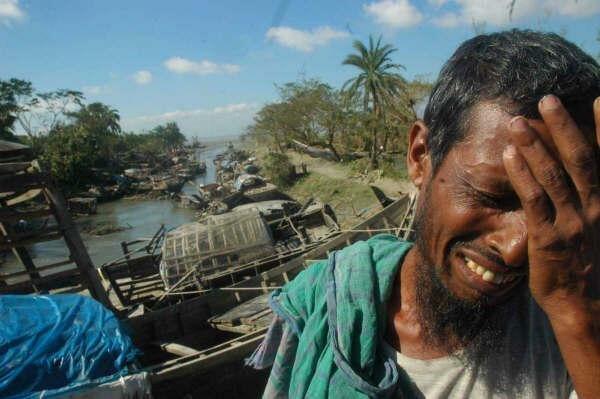Aid in Bangladesh?
Despite "relatively modest” development assistance, poverty and malnutrition remain prevalent in Bangladesh.
 While Bangladesh has made significant efforts to boost aid effectiveness, questions remain over who is benefiting from the US$1.5 billion in foreign aid the country receives annually.
While Bangladesh has made significant efforts to boost aid effectiveness, questions remain over who is benefiting from the US$1.5 billion in foreign aid the country receives annually.
“The way foreign aid is spent [here] cannot reduce poverty,” Anu Muhammad, professor of economics at Jahangirnagar University in a district neighbouring the capital, Dhaka, told IRIN. "It seems the objective is not to reduce poverty but rather benefit a very small interest group of bureaucrats and consultants.”
While the rate of poverty fell by 8 percent from 2005-2010 the UN estimated some 58 percent of the country’s 150 million people were still poor in 2011 as measured by access to health, education and safe living conditions.
In 2010 Bangladesh was the 22nd largest recipient of humanitarian aid globally and received $1.4 billion in both development and humanitarian aid that year.
Linda Poole, programme leader of global humanitarian assistance at the UK-based NGO Development Initiatives, put the aid figure into perspective.
“Official development assistance funding from international donors… to address chronic poverty and vulnerability to crises is relatively modest in relation to the scale of poverty and the numbers of people periodically affected by natural disasters.” One of the aims of foreign aid is to prepare communities to withstand – and survive – disasters.
According to the Brussels-based Centre for Research on the Epidemiology of Disasters, since 2000 nearly 100 natural disasters have killed an estimated 9,500 people in Bangladesh, ranked one of the 10 most vulnerable - but least prepared - countries worldwide to natural disasters, according to the UK-based global risk assessment company, Maplecroft.
Malnutrition
The country decreased the rates of under-nutrition among children under-five from 66 percent in 1990 to 41 percent two decades later. In 2011 the Paris-based NGO, Action Against Hunger (ACF), singled out Bangladesh as a “success” story for this achievement.
Yet without a national authority coordinating nutrition activities, monitoring of NGO nutrition work is “largely non-existent”, said ACF.
According to the country’s 2011 Demographic and Health Survey, some 40 percent of children under five are considered to be too short for their age - a sign of chronic malnutrition - and 16 percent had signs of wasting (also known as acute malnutrition, or they were too short for height), slightly over the 15 percent threshold that marks a nutrition emergency, according to international aid groups.
These stubbornly high figures are, in part, due to aid mismanagement, said Muhammad. "Roughly, 80-85 percent of foreign aid is spent on foreign tours for bureaucrats and consultancy fees rather than on the poor,” he said, based on his research. “Foreign aid does not address the real causes of our poverty or our vulnerability to disasters,” he added.

Corruption
In 2011 the Berlin-based NGO, Transparency International, ranked Bangladesh 120 among 183 surveyed countries for how corrupt their public sectors are perceived to be. The NGO’s study on daily corruption calculated that 66 percent of the population paid officials bribes to access basic government services.
However, for Muhammad from Jahangirnagar University, fighting corruption is only part of the solution. "We should review the entire [aid] process and see what benefit we really get, as we have been taking foreign aid for quite a long time," he said. “The whole process of the aid system is faulty. It’s time to learn to mobilize our internal sources.
“It is a complex issue whether the foreign aid is helping the country or not,” said Piash Karim, an economics and sociology professor at BRAC University in Dhaka. “People are getting very little of the total amount, with a corrupt group of NGOs and government officials benefiting. It is not possible to give evidence, but there are allegations of corruption in foreign-aid [funded] projects,” he added.
Management is an important step to whittling down the country’s aid dependency, said Ahmed Swapan Mahmud, executive director and founder of Voice, a rights-based research and advocacy organization in Dhaka.
“Only in the context of democratic values can transparency and accountability of the aid system be ensured. But a strong democratic and institutional framework to achieve real development is still a long way [off].”
Bangladesh’s humanitarian aid community is described by many as the world’s largest. On top of the 12 UN agencies and the 77 international NGOs, there are more than 2,000 officially registered local NGOs, and over 60,000 community-based organizations (CBOs).
An international aid worker, who preferred to remain unnamed, told IRIN the real constraints are lack of good coordination of bilateral aid, poor governance and the excessive bureaucracy that surrounds aid. “There is a need of a total revision of the aid system, more transparency and a strong will to tackle the priorities in aid.”
And while the country may meet some of its Millennium Development Goals (MDG), the problem is how to maintain achievements, the worker added.
To improve socioeconomic conditions in the world's poorest countries, the UN established eight international development goals in 2000, three of which Bangladesh is on track to meet (eradicate extreme poverty, reduce child mortality and improve maternal health).
Quality of project design

















